Menu
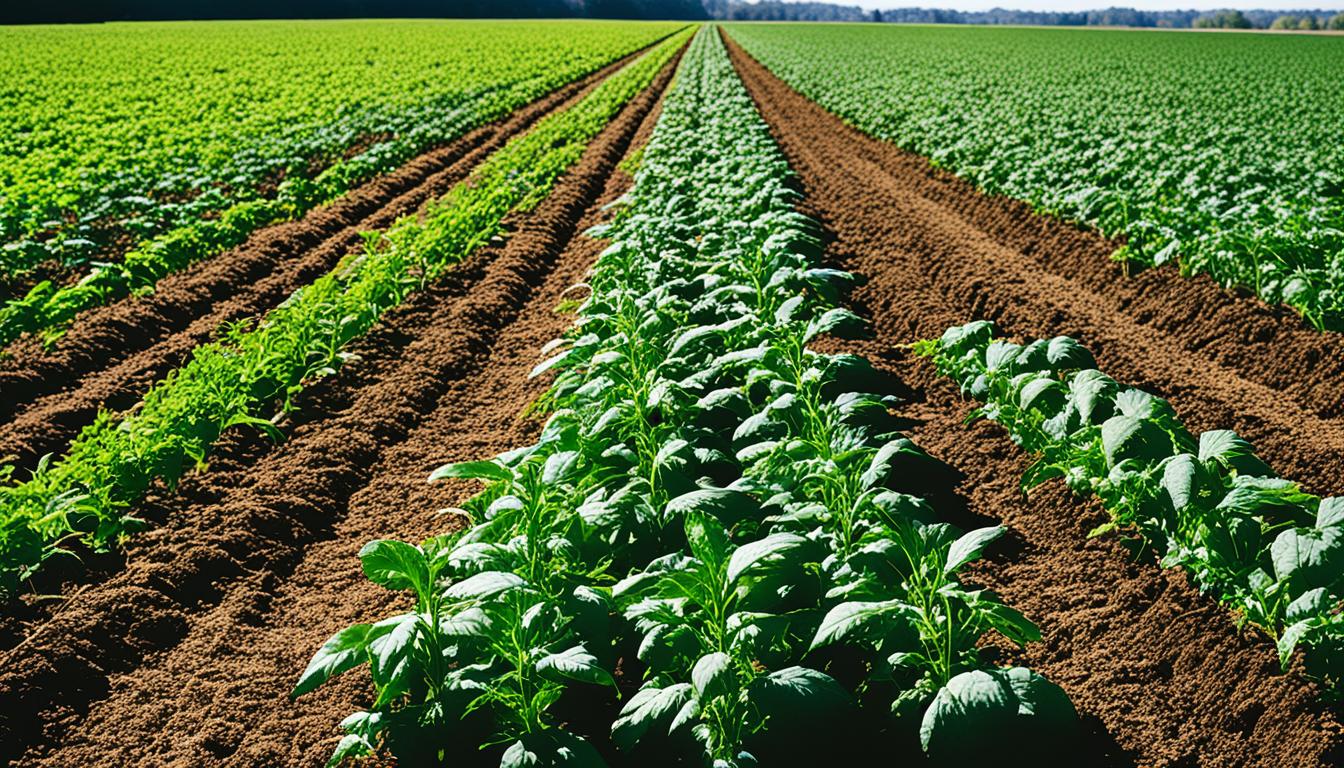
Did you know that organic growers use many tools for weed control? They use everything from tillage tools and cultivation implements to mowers and flame weeders. This variety is key for fighting weeds in organic farming without using chemical sprays. Organic farmers rely on a wide range of tools, such as plows and cultivators, showing weed management is complex for them.
Primary tillage tools dig quite deep, 6-8 inches. They help change the soil and reduce the number of weed seeds. Secondary tools prepare the ground for planting. For instance, the chisel plow and field cultivator are great for tough weeds, as they pull their roots up to dry out.
Tools for weeding between rows, like torsion and finger weeders, are crucial. They pick out little weeds without disturbing the main plants. Yet, even though tilling can kill weeds, it can also hurt the soil. Balancing these actions, alongside crop rotation and using cover crops, improves how we farm sustainably.
Organic farming faces unique hurdles, especially in tackling weeds. The USDA Final Rule forbids the use of synthetic herbicides. As a result, we need a mix of methods for eco-friendly weed removal.
Knowing weed species’ lifecycles is key to getting rid of them organically. For example, crop rotation can stop weeds growing by changing their living conditions. It also helps your plants by cutting down on the resources weeds need.
Mechanical methods of weed control are also very good, even though they require more work. For example, covering the soil with plastic in hot weather can kill weed seeds with heat. Flaming equipment offers a way to get rid of weeds without lots of manual labour.
Mulching, whether it’s with things like straw, plastic, or by planting living ground cover, keeps out light that weed seeds need to grow. We can also use allelopathy by planting certain crops that make chemicals which stop weed seeds from growing. This is another helpful method in our non-toxic approach.
Biological weed control is a new idea but looks promising. It involves using creatures that feed on or attack weeds. Only a couple of organic herbicides are available, like corn gluten and acetic acid. While they’re not super strong, they still help in our fight against weeds.
| Weed Management Techniques | Advantages |
|---|---|
| Crop Rotation | Disrupts weed cycles by changing the crop habitat |
| Mechanical Management | Labour-intensive but highly effective |
| Thermal Weed Control | Cost-effective by rupturing plant cells through heat |
| Soil Solarization | Kills weed seeds using plastic film during warm seasons |
| Mulching | Blocks light to prevent seed germination |
| Allelopathy | Uses plant chemicals to inhibit weed growth |
| Biological Management | Employs natural organisms for weed control |
Crop rotation is key in organic farming, essential for fighting weeds without chemicals. It works by changing what is planted and when. This disrupts weed cycles and boosts the soil’s health. This is key in any good organic weed-fighting plan.
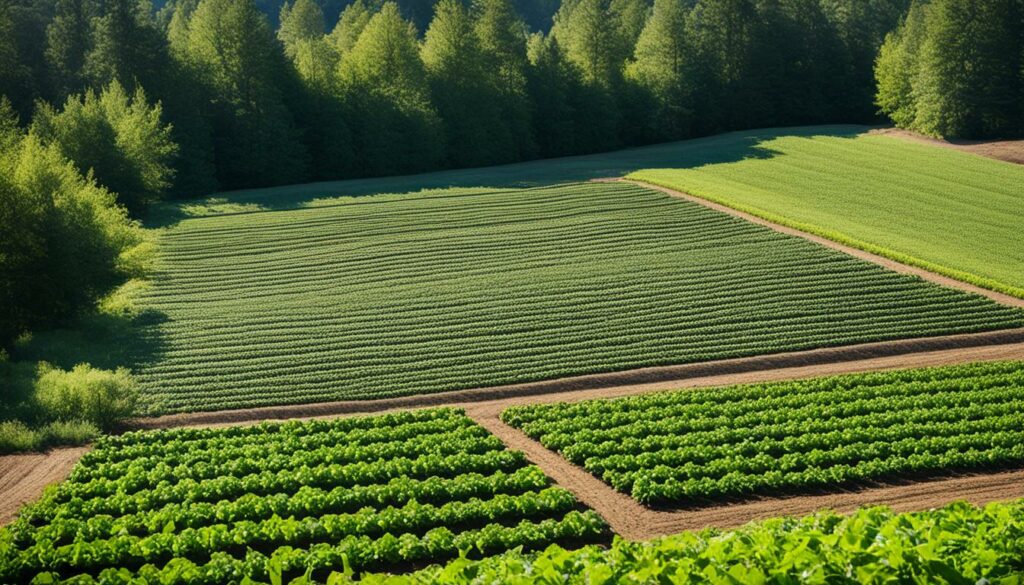
Weeds love when everything is the same. So, mixing up what’s planted helps stop them from taking over. By switching the plants, some out-compete weeds better. This lowers the number of weeds. Growing winter wheat in between can really put a stop to some tough weeds like quackgrass.
Also, planting things like fall rye stops fields from being empty in the summer. These plants naturally fight weeds. The way crops are rotated is crucial for keeping weed killers out of organic farms.
Crop rotation goes beyond just fighting weeds. It’s amazing for the soil. Mixing in grasses and legumes makes the soil better for growing. Using these plants is important since some good soil friends stopped being used in the 1940s.
Using these plants in a circle helps more than just doing nothing or only plowing. Mixing what’s planted can lower the number of weed seeds. This makes for lasting success in organic farming.
Cover crops help prevent weeds in a natural, eco-friendly way. They also boost soil health. By choosing and managing them wisely, you can greatly reduce weed issues.
Different cover crops are used for suppressing weeds, depending on farm needs:
Cover crops do more than just stop weeds:
| Benefits | Details |
|---|---|
| Weed Suppression | They cut weed growth by 80%-100% by competing for essentials. They particularly excel at reducing certain weeds by large margins. |
| Soil Health Improvement | Mixes specially enhance the soil’s structure and health. They often increase the soil’s water holding and nutrient-carrying abilities. |
| Erosion Prevention | These crops cover soil, stopping it from eroding. This keeps the soil healthy and in place. |
| Nutrient Cycling | Some cover crops add nitrogen, while others keep nutrients in the soil. This improves the soil’s overall fertility. |
| Reduced Herbicide Use | They lessen the need for chemicals in growing cotton and peanuts. This makes farming more eco-friendly. |
Effectively using cover crops is good for the environment and fights weeds. It makes the land healthier over time and benefits crops by reducing weed competition.
Today, many are stepping away from pesticides and herbicides sold in stores. They’re turning to methods for weed control that are kind to the earth. In this discussion, we’ll cover two main techniques: hand weeding and flame weeding.
Removing weeds by hand is a method that’s tough but very effective. It makes sure that the whole root is removed, especially with tough weeds like dandelions. More and more people are choosing this method because it’s safe for our planet. Even though it takes more time and energy, hand weeding is chemical-free and gives you full control over the weeds.
Flame weeding is becoming a popular choice for eco-friendly weed control. It’s great for stopping weeds before they grow, which lessens the need for herbicides. Using flame torches offers a quick way to deal with weeds. People enjoy the added benefit of seeing the flames in action, making it a fun and eco-friendly choice.
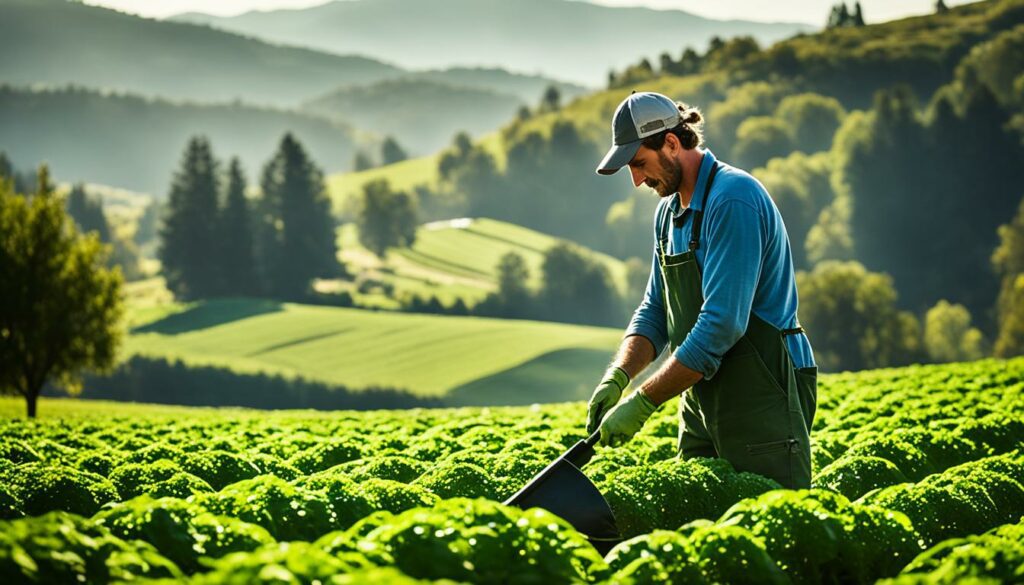
Both hand weeding and flame weeding have their own advantages. By using these along with other green techniques, we can keep the weeds in check in a nature-friendly way.
Using natural herbicides is a big win for those wanting to avoid toxic weed killers. Chemical weed killers can seep into the ground and harm our water systems. This danger has pushed more people towards organic ways. Let’s dive into the world of non-synthetic weed killers and what they offer.
Vinegar is a star player in non-synthetic weed control. The acetic acid in it dries out weeds, effectively killing them. It’s a safe and eco-friendly option, working best when the sun is shining.
Compost, nature’s fertiliser, also fights weeds. It stops weed seeds from growing. This way of weed control is deeply tied to keeping the soil in good shape. Good soil health means fewer weeds without the need to kill them directly.
Natural herbicides are great because they’re safe for the Earth. But, they only kill what they touch. This means the roots might still sprout new weeds. So, we have to apply them carefully and sometimes use other methods too.
Knowing the up-and-downs of natural weed killers helps us build healthier farms and gardens.
| Natural Method | Advantages | Limitations |
|---|---|---|
| Vinegar (Acetic Acid) | Non-toxic, easily accessible, effective on sunny days | Limited to foliage, roots remain intact |
| Compost | Improves soil health, suppresses weed seeds | Requires time and effort to produce |
| Hand Weeding | Complete removal of weeds, physical exercise | Labour-intensive, impractical for large areas |
Mulching is key in organic weed eradication. It provides a chemical-free way to stop weeds from growing. There are several types of mulch, each with its unique strengths, making it perfect for various needs.
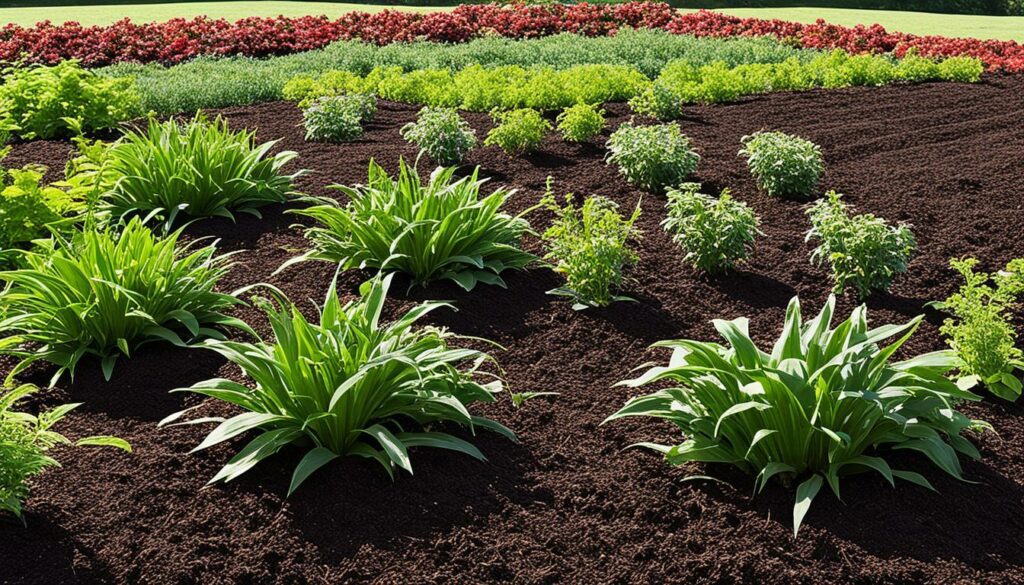
Many materials can work as great mulch. Hay mulch, for example, is top-notch for weed control. A 3–4 inch layer will really help reduce new weeds, especially those fast-growing ones. Grass hay has more potassium and keeps weeds down well, but watch out for using too much of it. Make sure the hay you get didn’t have herbicides, or your veggies might suffer.
Leaf and plastic mulches are good too. They block light from weeds and save moisture in the soil. Leaf mulch is full of good stuff for the soil. Plastic mulch lasts a long time, giving tough protection against weeds.
How you apply mulch matters a lot for chemical-free weed suppression. It’s important to spread it evenly and keep a certain thickness. For hay mulch, pick the first cutting to avoid growing more weeds. If you get grass hay, letting it sit out in the rain reduces its chances of seeding more weeds. But be aware, rain and time can turn hay into a health hazard with mould.
Choosing the right mulch depends on what you’re growing and your land. And, keeping an eye on your mulch and making changes when needed helps a lot. Doing all this not only keeps weeds at bay but also improves the soil, giving great results in organic weed eradication.
Organic weed management needs smart use of tillage tools. These tools are key in preparing soil and keeping weed numbers down. They change soil in many ways, like cutting and pounding. Knowing how tillage tools work in the farm helps control weeds well.
Primary tillage gets the soil ready first. It mixes in old plants and pulls up weeds.
These tools turn over the soil up to 6 to 8 inches deep. This step is good for fighting weeds. It makes their seeds start growing, which can actually help get rid of them.
After primary tillage, the soil is made even better for seeds and crops. This is where secondary tillage comes in. It makes the soil perfect for planting.
Secondary tools make the soil soft and ready for seeds. They also cut down on weeds. Tools like the rotary hoe are great at stopping new, small weeds.
Using primary and secondary tillage makes the land ready and cuts down weeds. Farmers should carefully pick and use tillage tools for the best weeding outcome. It’s essential for good organic weed control.
| Tillage Tool | Type | Function |
|---|---|---|
| Moldboard Plow | Primary | Inverts soil, buries weeds |
| Chisel Plow | Primary | Uproots existing weeds |
| Disk Harrow | Secondary | Breaks soil clods, fines seedbed |
| Field Cultivator | Secondary | Prepares seedbed, reduces weed population |
The world of organic farming has changed a lot with new innovative cultivation tools. These tools help farmers take care of weeds without using chemicals. They are precise and efficient, meaning crops are less likely to get hurt while killing weeds accurately.
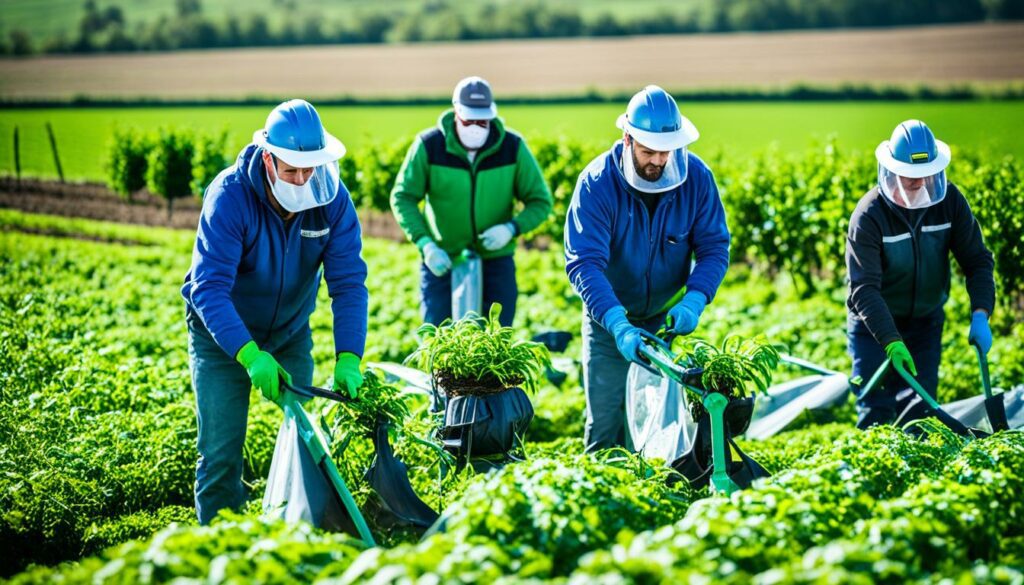
One big step forward is LaserWeeder. It can zap up to 5,000 weeds every minute. This fast work boosts how much crops grow and saves money for farmers. It can clear two acres of weeds in just one hour. That means farmers can spend more time on other important farm tasks.
Farmers who use laserweeding save a lot of money. They spend around 80% less on getting rid of weeds. The machine pays for itself in one to three years. And it can be used for seven to ten years. This shows laserweeding is a smart and money-saving choice, especially with rising costs.
LaserWeeder also fits well with organic farming beliefs. As organic rules ban certain weed killers, LaserWeeder helps farmers be more organic. It plans to make more organic food available, meeting the fast-growing demand for food without chemicals.
Roller crimping is another cool method for organic farming without tilling. Experts like those at the Rodale Institute and Dr. Erin Silva from the University of Wisconsin give it a thumbs up. Solutions like flame weeding from the University of Nebraska-Lincoln also show how important new tools are in eco-friendly farming.
Then there’s Underground Agriculture, by the CEO of Dawn Equipment. It focuses a lot on making tools for getting rid of weeds organically. It’s the first company to really concentrate on this, showing a big move towards using the best tools in organic farming.
Everyone working together – researchers, businesses, and farmers – is improving the ways we control weeds safely. These efforts not only make weeding more efficient but also help the environment and the whole farming system.
It’s key to know how weeds grow to control them well. Weeds can be annual, biennial, or perennial. Each needs different handling to keep them in check and ensure the land stays healthy.
Annual weeds only live for one year. They can either grow in summer or winter. For example, lambsquarters and barnyardgrass are summer annuals. They sprout when it’s warm. On the other hand, henbit and chickweed are winter annuals. They grow when the weather is cooler.
Using organic methods is a great way to tackle annual weeds. These include changing crops and covering the soil with crops when not in use. Also, herbicides can help. They stop seeds from growing or kill young plants. This can work for both summer and winter annuals.
Perennial weeds last for many years. They can grow from different parts hidden underground. This makes them harder to fight. Special herbicides like glyphosate can help. They move through the whole plant.
In lawns and gardens filled with perennial weeds, a thick healthy bed of grass helps a lot. So does mowing high. This creates shade and stops weed seeds from sprouting. When spreading weeds are a problem, it’s best to prevent them early. Plus, you can use special fabrics in your garden. They stop light getting to the soil, which weed seeds need to grow.
| Weed Type | Examples | Germination Period | Control Methods |
|---|---|---|---|
| Annual Weeds | Lambsquarters, Barnyardgrass | Spring to Summer | Crop Rotation, Preemergence Herbicides |
| Winter Annual Weeds | Henbit, Chickweed | Late Summer to Early Spring | Cover Cropping, Contact Herbicides |
| Perennial Weeds | Dandelion, Ground Ivy, Quackgrass | Throughout the year | Maintaining Thick Turf, Systemic Herbicides |
Choosing the right time to plant and the amount of seeds to use is key in beating weeds. Doing this well boosts how well our crops grow. It can also cut down on the weeds that bother our plants when they are young.
Picking when we put our seeds in the ground is a smart move in fighting weeds. Waiting for the ground to warm up before planting helps our crops start strong. This advice comes from Hill in a book from 2006.
He says we should pick crops that grow fast and cover the ground quickly. This makes it hard for weeds to grow. Using this method is great for onions. A 2008 study found that planting them as young plants can make our harvest bigger and cuts down on weeding.
How close we plant our seeds is also important. Putting more seeds in can stop weeds from growing. They have less space and light to thrive between the crops. At Clear Springs Farm, Terry Kromer uses ryegrass to fill these weed gaps and it works well.
Some crops are better than others at fighting weeds, as Callaway said back in 1992. Picking the right crops can really help. In 2005, work at Cornell University showed that by planting in a clever way, they reduced pigweed seeds by 75% in a year. This shows how choosing the right seed amount can really impact weed growth.
Thinking about when and how closely we plant is crucial. It helps our crops do better, and keeps weeds at bay. These methods are good for the environment, showing how we can farm well while being kind to the planet.
Looking after our farming methods is key to stopping weeds. It keeps crops strong and soil healthy. This reduces weeds and helps crops grow better.
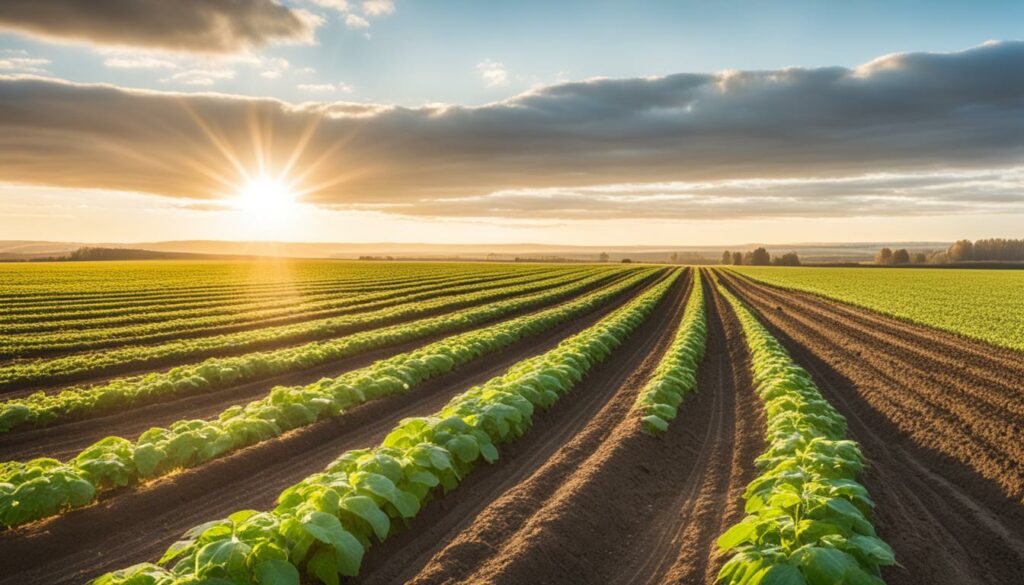
Having a dense crop stand can stop weeds from growing. It blocks out light, moisture, and nutrients. This makes it hard for weeds to thrive.
Changing crops through the seasons stops weeds from taking over. Placing crops like lettuce and radishes together helps too. They’re quick to harvest, so they don’t let weeds spread.
Good soil is a must for crops to win against weeds. Adding things like organic matter and cover crops makes soil better. It also stops weeds from growing.
Plants like alfalfa can keep down some weeds. They use up the resources these weeds need to live. Choosing the best seeds and giving soil what it needs also helps crops fight off weeds.
| Strategy | Benefits |
|---|---|
| Crop Rotation | Disrupts weed life cycles and boosts soil health. |
| Short Cycle Crops | Reduces weed populations by preventing seeding. |
| Annual and Perennial Forages | Effective in suppressing specific weed populations. |
| High-Quality Seeds | Ensures vigorous crop growth, reducing weed competition. |
Using these methods together helps fight weeds well. It’s all about keeping the farm healthy. Changing crops and using good seeds are just a couple of ways we can beat weeds.
Mechanical weed control methods are key in fighting weeds, especially in organic weed management. They involve using tools to disturb the soil, stopping weed growth. In North America, farmers use different tillage methods. This ranges from not digging at all to turning the soil completely with ploughs.
Primary and secondary tillage play a big role in these methods. Primary tillage goes deep, breaking roots and covering weeds. Secondary tillage is done closer to the surface to get the soil ready for planting. Some systems keep over 40% of the old plants on the ground. This helps keep the soil healthy.
It’s also important to think about what different tillage does to weed seeds. Some methods are better at hiding seeds or bringing old ones back up. How well this works depends on where the seeds are and the weather.
Using the right tools before and after planting is key for mechanical weed control strategies to work well. Tools like tine weeders and cultivators disturb the soil less but still get rid of weeds. Tine weeders, like the ones from Hatzenbichler and Einbock, have different settings for different soils.
New technology, like cameras on cultivators and finger weeders, makes weed control more precise. These tools save time and help get better results.
It’s also crucial to consider how different tillage methods affect the spread of weeds with underground parts. The right approach can stop weeds from spreading. This is important for organic weed management.
In the end, using the right mechanical methods and knowledge, farmers can decide what works best for their organic farming.
We’re working hard to make farming last a long time. Now, sustainable ways to manage weeds are very important in organic farms. Integrated Weed Management (IWM) is key. It mixes several eco-friendly techniques to get rid of weeds. These methods are chosen for each farm’s special needs.
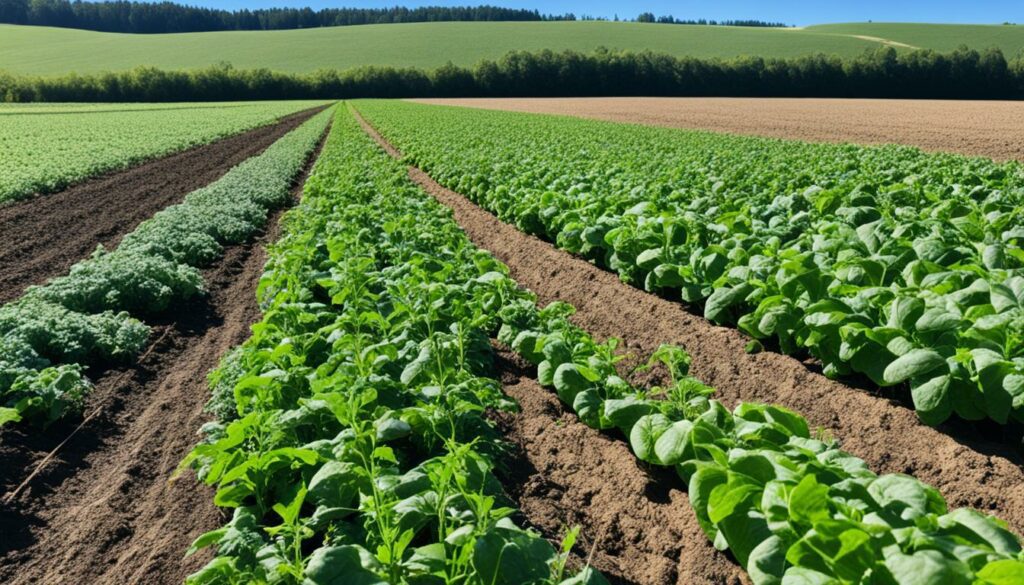
IWM uses different organic methods together. This helps us fight weeds without using man-made chemicals. In the U.S., organic farmers can’t use these chemicals. So, they rely a lot on things like changing the types of crops planted and using machines to control weeds.
IWM also uses machines, heat, and certain plants to fight weeds. It makes a full plan for managing weeds.
Using IWM is good for our planet in big ways. It makes our land more diverse, stops soil from washing away, and makes farming areas healthier. This focus on green techniques keeps the soil good and helps create a mix of farm-friendly places.
Keeping our weed control methods up-to-date is key. We must use the right tools and techniques to keep weeds in check. It’s about finding a balance where our soil and crops stay healthy.
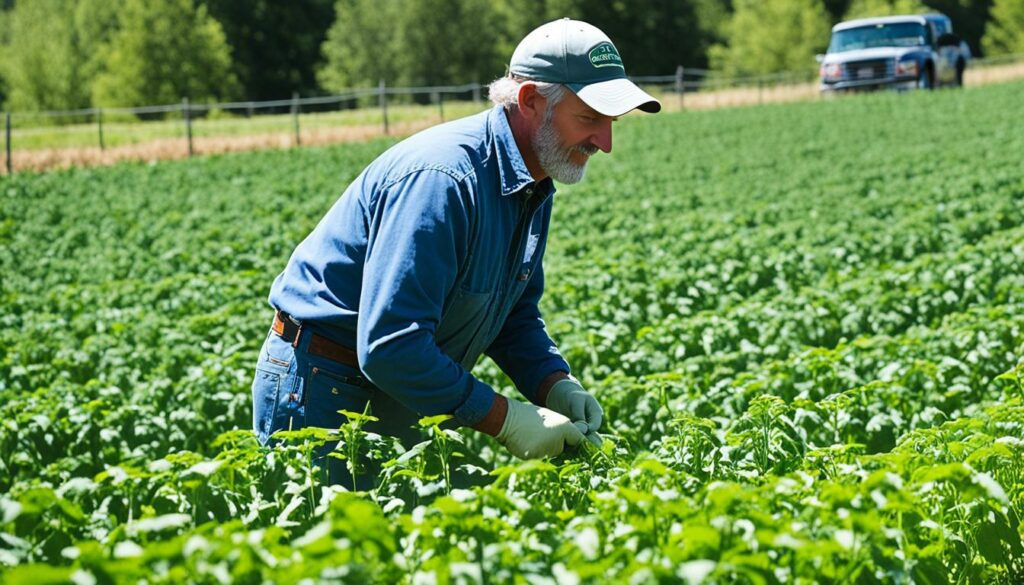
Checking fields often helps us catch weeds early. This lets us quickly work out plans to handle them. Tools like moldboard plows, chisel plows, and disk plows are great for digging down 6 to 8 inches to disrupt weeds. If you’re working on a smaller scale, tools like shovels and spading forks are also good at getting rid of weeds. Then, we use tools that go shallower, like field cultivators and rotary tillers, to tidy up.
Always learning helps us get better at fighting weeds. For example, using tools like rotary hoes, spiketooth harrows, and interrow cultivators can really help. With interrow cultivators going about 2 to 4 inches deep, we can cut off weeds without hurting our crops much.
Trying out new tools, such as torsion weeders and finger weeders, can help us handle small weeds while protecting our crops. Learning about the latest in thermal weed control and soil solarisation brings more options too.
Sharing what we know and keeping up with the latest research helps us weed smarter. This makes our work better every day and keeps our farms sustainable in the long run.
We’ve looked at how important it is to use different ways to stop weeds without chemicals. Because organic farmers can’t use synthetic weed killers, they turn to methods like using tools for farming or hand-pulling weeds. This change is hard work but worth it for the environment.
Crop rotation, which people have done for centuries, is key in fighting weeds without chemicals. It disrupts weed growth and keeps the soil healthy. Another helpful method is placing a layer of mulch on the soil to stop light, which stops weed seeds from growing. Also, preparing the soil without planting for a while can get rid of weed seeds already in the ground.
Though we’ve made great progress, there’s still much more to learn about stopping weeds organically. Methods that use other organisms to fight weeds, like bugs that eat them, could be very useful. The fact that some weeds can produce a huge number of seeds shows why managing them is so hard. Finding good ways to manage weeds without chemicals is good for the planet and our food.
Organic methods for weed control use crops, tools, and nature. Farmers rotate crops, grow special plants, and use no-chemical tools. This way, they stop weeds but keep the earth healthy.
Changing the types of crops grown stops weeds from getting too strong. It also makes the soil better. Knowing what weeds like helps farmers beat them.
Some plants, like rye and mustard, hurt weed seeds. They make the ground better, prevent soil loss, and keep weeds out. This makes them great to use.
Pulling weeds by hand is kind to the planet but needs hard work. Flame weeders burn weeds fast, saving money and avoiding chemicals.
Vinegar can kill weeds and is safe for the planet. But it only works on the top part of the weed, not the roots.
Mulch like straw or plastic keeps light away from weed seeds. It also keeps the soil damp. Putting it on right stops weeds well.
Some tools stir the soil deeply, pulling up weeds. Others make the ground ready for seeds. Choosing the right one helps with weeds.
New farming tools clear whole fields of weeds or just between rows. They don’t hurt crops and work well for organic farming.
We need to know if weeds come back every year or stay short-lived. This changes how we stop them from growing.
Planting at just the right times and distances makes it hard for weeds to grow. This strategy uses plants’ power to fight weeds off.
Growing crops closely and caring for the soil blocks the light weeds need. Healthy soil also helps crops beat weeds.
Tilling the soil or using special machines can get rid of weeds. The trick is doing it at the perfect time.
IWM mixes many green ways to stop weeds, keeping farms healthy for years. This helps all life on the farm and makes it stronger.
Watch fields closely and always learn how to garden better. Keeping up with new ways helps fight weeds in a natural way.